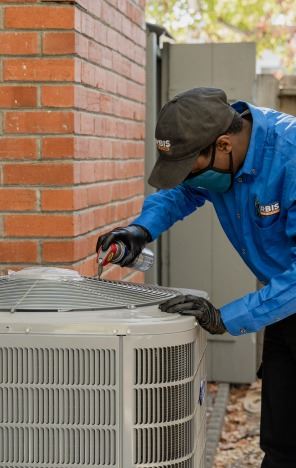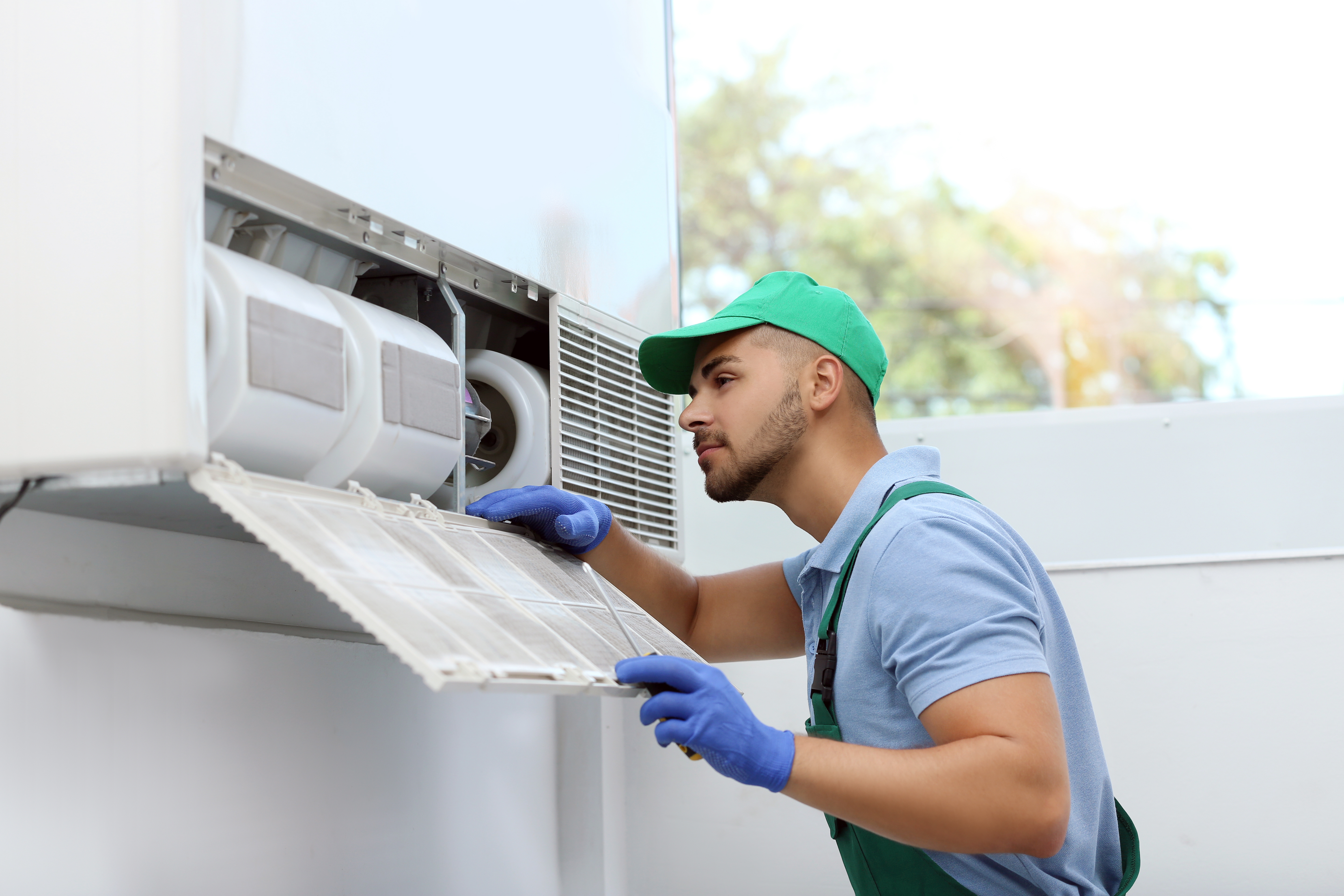The Ultimate Breakdown of ductless mini splits vs Central Heating Systems
The Ultimate Breakdown of ductless mini splits vs Central Heating Systems
Blog Article
How a Heat Pump and Furnace Work Together to Optimize Your Home's Home heating Performance
Recognizing just how a heatpump and heating system interact is vital for property owners looking for reliable home heating remedies. Each system has its strengths, providing a well balanced technique to home comfort. The heatpump masters modest temperature levels, while the furnace supplies fast warmth during severe cold. This harmony not just decreases energy expenses but additionally boosts the life expectancy of both devices. What elements influence this collaboration, and exactly how can property owners maximize their advantages?
Understanding Warm Pumps: Just How They Function
Numerous individuals might be unfamiliar with their inner workings, heat pumps play an essential duty in contemporary heating systems. These devices run by transferring warm from one area to an additional, using the principles of thermodynamics. In colder months, a heatpump essences heat from the outdoors air, ground, or water, and transfers it indoors to warm up the space. Alternatively, during warmer months, it can reverse the process, functioning as an air conditioner by eliminating warm from inside to the outside.Heat pumps include an evaporator, condenser, compressor, and growth valve. The cooling agent within the system takes in heat as it vaporizes at reduced temperatures and pressures. The compressor then boosts the pressure and temperature level of the refrigerant, permitting it to release heat as it condenses. This efficient procedure can greatly reduce power intake contrasted to standard heating methods, making warmth pumps a sustainable selection for climate control in homes.
The Role of Furnaces in Home Heating
Furnaces play a crucial role in home heating by giving a trustworthy resource of heat throughout the colder months. They run by generating warmth with combustion or electrical resistance, dispersing it throughout the home using ducts or radiant systems. The effectiveness of a furnace is often gauged by its Yearly Gas Application Effectiveness (AFUE) ranking, which shows exactly how properly the unit transforms fuel right into heat.Furnaces can utilize different energy resources, including gas, oil, gas, or electrical energy, allowing home owners to select the most appropriate choice for their needs. Unlike warmth pumps, which might battle in extreme chilly, heating systems keep constant efficiency, guaranteeing that interior temperatures remain comfy no matter outside conditions. In addition, modern heating systems usually come equipped with advanced technology, such as variable-speed blowers and clever thermostats, boosting their efficiency and responsiveness. This adaptability makes heaters a critical element in all-inclusive home heating methods.

Benefits of Making Use Of Both Systems With Each Other
Incorporating the toughness of both heaters and heat pumps can cause an extra efficient and reliable home heating service. Making use of both systems allows house owners to benefit from the heatpump's energy performance during milder temperatures while depending on the heater for more severe cold conditions. This twin approach can substantially lower energy costs, as heatpump eat much less electrical power than traditional heating techniques when temperature levels are moderate.Additionally, making use of both systems with each other can enhance comfort levels in the home. Warmth pumps can give regular, also heating, while heaters can swiftly increase ambient temperatures when required. Additionally, the integration of both systems can prolong the life expectancy of tools by reducing wear and tear on each unit, as they share the workload. Ultimately, property owners can take pleasure in a balanced, cost-efficient heating service that readjusts effortlessly to varying climate condition, making certain a warm and inviting home throughout the winter season.
Just How Warm Pumps and Furnaces Complement Each Other
When house owners incorporate heatpump and heaters, they produce a corresponding heating unit that takes full advantage of efficiency and comfort. Heatpump run by transferring warmth from the outside air or ground, making them highly effective in moderate climates. They stand out during milder temperature levels, offering affordable heating. Alternatively, heaters generate warm via combustion or electric resistance, supplying strong, immediate warmth throughout severe chilly conditions.The combination of these two systems permits for vibrant adjustments based upon temperature level fluctuations. Throughout warmer months or milder winter season days, the heat pump can take the lead, preserving energy and minimizing prices. As temperature levels decline, the furnace can effortlessly involve, ensuring consistent heat throughout the home. This synergy not only maximizes power use but also boosts the life expectancy of both systems, as each system operates within its ideal efficiency variety. Together, they create a balanced atmosphere that adapts to differing environment demands.
Enhancing Performance: Tips for Homeowners
House owners can enhance their home heating efficiency through numerous practical approaches. Developing a normal upkeep routine, incorporating wise thermostat technology, and carrying out efficient insulation and securing remedies are crucial actions. These measures not just boost convenience yet additionally reduce power costs.
Routine Maintenance Set Up
To guarantee optimal heating efficiency, developing a routine upkeep timetable is crucial for any home. Property owners ought to focus on routine inspections of both heatpump and furnaces to establish peak performance. This includes changing air filters every one to three months, as blocked filters can significantly decrease performance. Additionally, scheduling expert maintenance at the very least as soon as a year enables technicians to recognize and attend to potential issues prior to they escalate. Property owners need to additionally cleanse the warm pump's outdoor system to avoid debris accumulation that can hinder airflow. By sticking to a routine maintenance timetable, homeowners not just enhance their heating systems' effectiveness yet also prolong their life-span, causing greater convenience and reduced power expenses throughout the cooler months.
Smart Thermostat Combination
Incorporating a clever thermostat right into a home furnace can substantially boost power performance, specifically as it allows for accurate control over temperature level setups. These gadgets can learn the property owner's schedule and choices, instantly adjusting the temperature level to maximize convenience while lessening power use. For instance, they can reduce heating throughout times when the home is vacant, minimizing unnecessary consumption. Numerous smart thermostats additionally give real-time power usage information, enabling property owners to make informed choices concerning their home heating habits. In addition, remote access through mobile phone applications permits individuals to readjust setups from anywhere, ensuring the home is cozy upon return. Generally, wise thermostat assimilation not only enhances comfort but substantially adds to power cost savings and effectiveness.
Insulation and Securing Solutions
Smart thermostats play a vital role in energy performance, however their effectiveness can be substantially boosted by proper insulation and sealing solutions. Home owners must prioritize shielding walls, attics, and floors to minimize warmth loss. use this link Top notch insulation materials, such as spray foam or fiberglass, can greatly improve thermal resistance. Furthermore, sealing gaps around air ducts, doors, and home windows prevents chilly air infiltration and heat retreat. Weatherstripping and caulking work methods for dealing with these leakages - ductless mini splits. Normal assessments for air leakages, together with the use of blower door tests, can aid identify problem locations. By buying insulation and sealing, homeowners can optimize the efficiency of their heating unit, ultimately bring about minimized power consumption and reduced energy expenses
Usual Misconceptions Concerning Heat Pumps and Furnaces
What misconceptions surround heat pumps and heaters? Many individuals erroneously think that warmth pumps are inefficient in cooler environments. In reality, contemporary warmth pumps are made to run effectively even in reduced temperatures, giving reputable heating throughout wintertime. An additional common myth is that heating systems are always much more effective than heatpump. Nonetheless, this relies on the certain power resources and performance ratings of the units concerned. Some might also assume that making use of both systems at the same time is unnecessary, yet as a matter of fact, this mix can optimize heating efficiency, particularly throughout extreme climate condition. Additionally, individuals commonly presume that warm pumps need consistent maintenance, when in reality, they have similar upkeep requires to traditional heater. By debunking these myths, home owners can make even more enlightened decisions concerning their home heating alternatives, eventually image source causing enhanced comfort and power effectiveness in their homes.
Maintenance Considerations for Combined Solutions

Often Asked Concerns
Can Warmth Pumps Work Properly in Extremely Cold Climates?
Heat pumps can have a hard time in incredibly cool climates because of reduced efficiency and warmth removal limitations. However, improvements in modern technology have actually resulted in models designed for better efficiency in such conditions, improving their viability in rough atmospheres.
The Length Of Time Do Warm Pumps and Furnaces Typically Last?
Warm pumps usually last 15 to twenty years, while furnaces have a life expectancy of 15 to thirty years. Normal upkeep can prolong their durability, making certain reliable operation and lowering the demand for premature substitutes.

What Is the Ordinary Expense of Putting Up Both Solutions?
The average price of setting up both a heat pump and a heater commonly ranges between $5,000 to $10,000 - click here for info furnace replacement. Aspects affecting this price consist of system size, installment complexity, and regional labor rates
Exist Tax Obligation Rewards for Utilizing Energy-Efficient Heating Equipments?
Numerous property owners ask about tax rewards for energy-efficient home heating systems. Different government and state programs usually offer discounts or credit histories, urging the fostering of lasting technologies to reduce energy usage and promote ecological duty.
Just how Do I Select the Right Size Heat Pump and Heater?
Picking the right size heat pump and furnace includes determining the home's square video footage, thinking about insulation top quality, and examining regional climate. Consulting a professional can assure suitable system performance and energy efficiency based upon certain needs. heat pump installation ooltewah tn. Understanding how a warmth pump and heater job with each other is necessary for home owners looking for effective heating remedies. In cooler months, a warm pump essences heat from the outdoors air, ground, or water, and transfers it inside to heat the living area. When homeowners incorporate warmth pumps and heating systems, they create a complementary home heating system that makes best use of performance and comfort. Heat pumps run by transferring warmth from the outdoors air or ground, making them highly reliable in modest climates. Warmth pumps can have a hard time in extremely cool environments due to reduced performance and warm removal limitations
Report this page